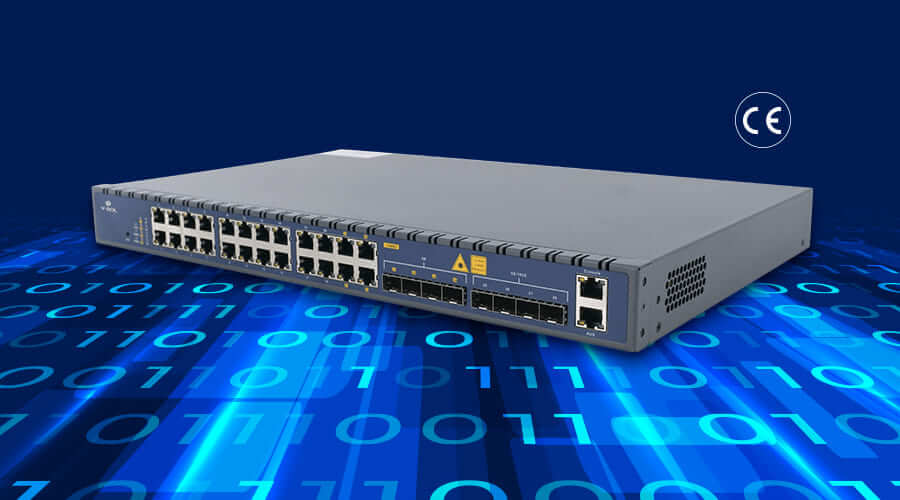Overview of Switch in a Computer Network
Overview of Switch in a Computer Network
The EPON OLT is a device serving as the endpoint for the service provider in a passive optical network. In other words, the Optical Line Terminal (OLT) manages the Ethernet Passive Optical Network (EPON). This technology offers multiple services thanks to its point-to-multipoint passive optical transmission.
1. What is a switch in a computer network?
4G CPE (Customer Premise Equipment) is a terminal device that can transfer 4G signals into WiFi signals to provide networks to hardware devices.Generally speaking, the switch is an information exchange device in the computer network of the telecommunications system. The switch focuses on physical addressing, network topology, error control, frame sequencing, and traffic control. The most common switch is the Ethernet switch. It can connect to multiple devices such as computers, wireless hotspots, printers and servers.

Switch working principle:
1. According to the source MAC address received in the data frame, the switch maps the address to the switch port and writes it into the MAC address table.
2. The switch decides which port to forward by comparing the destination MAC address in the data frame with the established MAC address table.
3. If the destination MAC address of the data frame is not in the MAC address table, it will be forwarded to all ports. This process is called flooding.
4. Broadcast frames and multicast frames are transmitted to all ports.
2. Types of Switches in a Computer Network
First of all, in light of the ISO structure, the switch can be divided into layer 2 switch and layer 3 switch.
● Layer 2 switch
The layer 2 switch operates on the second layer of the data link layer. It is able to identify the MAC address of the data frame, transmit based on the MAC address, and record these MAC addresses and corresponding ports in the indoor address table.
● Layer 3 switch
Layer 3 switch works on the network layer of OSI, which can be considered as a layer 2 switch with layer 3 routing functions. But it is an organic combination but just adding the firmware and software of the routers in the LAN switch.
For a more detailed introduction, you can turn to the article talking about Layer 2 vs Layer 3 Ethernet switch.
Then, regarding the different functions of the switch, it can be classified into managed switch, unmanaged switch, PoE switch and LAN switch.
● Managed switch
The managed switch aims to promise a well-functioning network. The managed switch provides various network management methods. Therefore, the network operator is able to monitor the status of the switch and network locally or remotely.
● The unmanaged switch
Unlike managed switches, unmanaged switches do not need to be configured. An unmanaged switch is typically used in basic network connections. For example, it is applied in your office, or in a meeting room. Unmanaged switch data is not…
● PoE switch
What makes PoE switch different from a general switch is that it can not only transmit data, but also provide AC power to connected devices. For example, the monitor is able to work by connecting to the power supply after connecting to the switch, which requires a power supply or wiring around the monitor and occupies much more space. Additionally, short circuit, fire and electric shock may occur due to trampling or uneven operation.
● LAN switch
LAN switch refers to data switching in local area network switching.
In traditional Ethernet, only one site can deliver data into the network at any time. Other sites must wait for data to be delivered. Therefore, the fixed bandwidth of the Ethernet share is shared by all sites and occupied randomly. The more sites there are in the network, the narrower the average bandwidth available to each site, and the slower the network response time.
Exactly, the switch fixes the problem. With LAN switch, data can be sent in parallel when the source node and destination node do not collide, which largely improves the transmission rate.
Finally, depending on the network structure and switch placement, there are core switch, aggregation switch and access switch. What we need to notice is that it is categorized based on the role the switch plays. For example, when the V-SOL Layer 3 Ethernet switch is applied to the aggregation layer, it is an aggregation switch. This would be an access switch if it operates at the access layer.
● Access switch
The access layer aims to enable terminal users to access the network, making the access switch low cost and high port density. It is also responsible for user management such as certifying addresses and users and collecting user information such as IP address, MAC address and visit history. It is common in life and widely used in general office, small computer room, multimedia production center, etc. In terms of transmission speed, most modern access switches provide multiple ports with an adaptive capacity of 10M/100M/1000M.
● Aggregation switch
The aggregation switch is the convergence point of multiple access switches, providing essential support. It helps uniformly export AP, transmit and route. Compared to the access switch, the aggregation switch needs higher transmission performance as it must be able to process all the traffic coming from the access devices and forward them to the layer uplinks. central. Additionally, the aggregation switch is a Layer 3 switch.
The aggregation layer switch is the aggregation point of multiple access layer switches. It should be able to handle all the traffic coming from the access layer devices and provide uplinks to the core layer, so the aggregation layer switch should have high transmission performance compared to the access layer switch, which is typically a layer 3 switch.
● Central switch
The core layer is the backbone of the network, which guarantees the performance of the entire network. Core switch is one of the core devices besides router, firewall and others. Thus, it requires a central switch with higher reliability, performance and throughput.
3. Application of Switch in Networking
Here we will introduce the application of network switches by taking V-SOL V35XX series switches as examples. All of these switches are Layer 3 managed Ethernet switches. The switches support ACL, selective QinQ, 1:1 and N:1 VLAN switching, Ethernet OAM, carrier grade QoS, industrial grade 10G Ethernet ring , etc.

As shown in the above frame, Layer 3 optical Ethernet switch V3528EF is placed at the aggregation layer. It's deposited in the server room and uplinks to the AC BARS server and downlinks to access switches. There are 16GE SFP, which exactly connects to the SFP of other access switches like V3528E and OLT like V1600G1-B. The RJ45 connects to terminal devices. The application of POL and FTTH is similar to what we introduced before. You can refer to the following related articles.
- Overview of Passive Optical Networks (POL): Benefits and Solution
– FTTH network: Application of GEPON outdoor reverse PoE ONU
Notes:
BARS is a bridge between the access network and the core network. It is a gateway that controls the export and import of user data to the central network.
In SOHO application, the access switch can adopt V-SOL V3E layer 3528 managed LAN switch. The switch has 24*GE (RJ45) ports and 4*GE/10GE (SFP+) ports. It connects directly to PCs, printers and routers with cooper.
When it comes to public areas such as highway tunnels, you can use the V-SOL V3-P Layer 3528 Managed Ethernet PoE Switch. What makes it different is that it supports PoE power supply, which is suitable for scenarios without electricity. It can connect to APs and IPCs.
As for enterprise application, V3E Layer 3552 Managed Ethernet Switch is a good choice. It has 48* GE (RJ45) ports and 4* 10GE/GE (SFP+) ports.
Now you know more about switches in computer networks? Looking for a Layer 3 managed Ethernet switch? V-SOL switch is the best choice!










